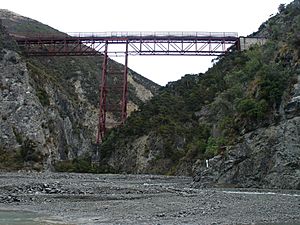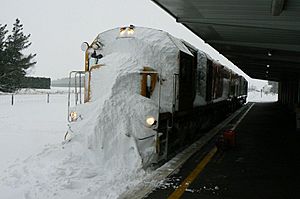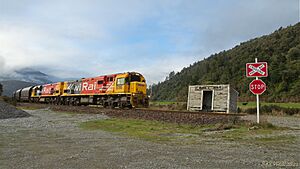Midland Line, New Zealand facts for kids
Quick facts for kids Midland Line |
|
|---|---|
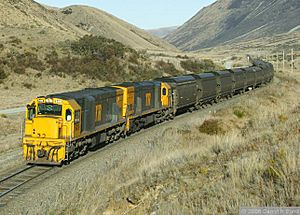
Two DX class locomotives in Tranz Rail Bumble-bee livery hauling a 1,800 tonne coal train on the Midland line in 2006.
|
|
| Overview | |
| Status | Open to passengers and freight |
| Owner | KiwiRail |
| Locale | South Island, New Zealand |
| Termini | Rolleston Greymouth |
| Service | |
| Type | Heavy Rail |
| System | New Zealand railway network |
| Operator(s) | KiwiRail The Great Journeys of New Zealand |
| History | |
| Opened | 4 August 1923 (complete line) |
| Technical | |
| Line length | 212 km (132 mi) |
| Character | Main line |
| Track gauge | 3 ft 6 in (1,067 mm) |
| Electrification | 1500V DC (Arthurs Pass to Otira, 1923 – 1997) |
| Maximum incline | 3% (1 in 33) in Otira Tunnel |
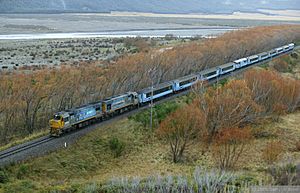
The Midland Line is a 212-kilometer (132-mile) railway track in the South Island of New Zealand. It connects the towns of Rolleston and Greymouth. This railway line is famous for its amazing scenery. It goes through five big bridges, five tall viaducts, and 17 tunnels. The longest tunnel is the Otira Tunnel. The popular TranzAlpine passenger train uses this route.
Contents
Building the Midland Line: A History of Challenges
In the 1870s, New Zealand was building railways to connect its main cities. These early lines mostly linked places like Christchurch, Dunedin, and Invercargill. They also built smaller lines to serve farms. One of these smaller lines reached Springfield by 1880.
People soon wanted a railway to connect the east and west coasts of the South Island. This was a big challenge because of the Southern Alps. In 1884, a special group chose the direct route through the Waimakariri Valley and Arthur's Pass. This route was shorter but much harder to build.
Overcoming Mountain Obstacles
Building the line was very difficult. Engineers had to deal with the steep Southern Alps. In 1886, a company called the New Zealand Midland Railway Company was formed. Their goal was to build this challenging railway. They also planned a line from Westport to Nelson.
However, the company only managed to build about 120 kilometers (75 miles) of the line. The government took over the project in 1895. By 1900, the line reached Otira on the west side and Broken River on the east side.
The hardest part was still ahead: getting through the Waimakariri and Broken River gorges. This section was about 13 kilometers (8.5 miles) long. It needed 16 tunnels and four major viaducts. A viaduct is a long bridge supported by arches, often used to cross valleys. The most impressive one is the Staircase Viaduct, which lifts the railway 75 meters (246 feet) above the stream below.
Building these parts was slow work. Men used picks, shovels, and horses. There was very little machinery. By 1906, trains could reach Broken River. This meant people could travel from Greymouth to Christchurch in one day by combining train and coach travel. The line slowly continued, reaching Cass in 1910 and Arthur's Pass in 1914.
The Otira Tunnel: A Huge Project
The biggest challenge was the Otira Tunnel. Construction started in 1907. It was very slow, and the first company quit in 1913. The tunnel was planned to be 9 kilometers (5.6 miles) long. While the tunnel was being built, coaches carried passengers between the two ends of the railway.
Despite the high costs and worker shortages during World War I, the government kept building. The Otira Tunnel was finally finished in 1923. This completed the entire Midland Line, connecting the east and west coasts by rail.
Passenger Trains: The TranzAlpine Journey
The Great Journeys of New Zealand operates a famous passenger train called the TranzAlpine on this line. This train runs every day. It uses DX class locomotives and special AK class passenger carriages. It's known for its incredible views of the Southern Alps.
Freight Services: Moving Goods by Rail
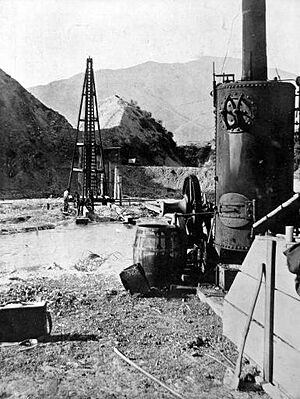
The Midland Line is very important for moving goods. A lot of the freight is coal. Other goods come from the Westland Milk Products factory in Hokitika. In 2003, about 2.1 million tonnes of coal were carried on this line.
Coal trains usually have two DX class locomotives. They pull about 30 coal hopper wagons. Each train can carry up to 1,800 tonnes of coal. Coal also comes from the Stockton Mine, north of Westport. These trains use the Midland Line for part of their journey.
Trains of the Midland Line
Over the years, many different types of locomotives have been used on the Midland Line. For example, the KB class steam locomotives were used between Arthur's Pass and Springfield. These were very powerful steam engines.
The Otira Tunnel was special because it was electrified from 1923 to 1997. This meant electric trains were used inside the tunnel. The English Electric EO class and later the New Zealand EA class locomotive were some of the electric trains.
In 1968, diesel trains started to be used. The DJ class and later the DC class became common. As more coal needed to be moved, the powerful DX class locomotives were introduced. Some of these were changed specially to work well in the Otira Tunnel.
Railway Structures: Tunnels and Viaducts
The Midland Line has 16 tunnels, including the very long 8,554-meter (5.3-mile) Otira Tunnel. It also has four major viaducts, which are tall bridges that cross valleys or gorges.
Here are the heights and lengths of the main viaducts:
| Name | Height | Length | Opened | Remarks |
|---|---|---|---|---|
| Staircase | 72 m or 236 ft | 149 m or 489 ft | 1906 | |
| Broken River | 55 m or 180 ft | 133 m or 436 ft | 1906 | |
| Slovens Creek | 39 m or 128 ft | 162 m or 531 ft | 1910 | |
| Pattersons Creek | 37 m or 121 ft | 186 m or 610 ft | 1906 |




